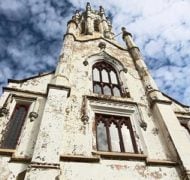Designed to Work: Redeeming Architecture
Blog / Produced by The High Calling
I am what is called a “necessity entrepreneur.” This is a nice phrase for people who started a business after losing their jobs in the recession: in my case, after thirty years as an employee of various small and large firms. In the five years since launching my practice, I’ve had many frustrations, setbacks, and wrong turns, but I’ve never for a moment doubted that God made me to be an architect. When I draw, I feel his pleasure.
When I started my own firm, I had the freedom and the opportunity to design a workplace according to Biblical principles and to let my work begin to answer the question, “What does redeemed architecture look like?”
Does it mean there are columns adorned with pomegranates on either side of the threshold? Scrolls of scripture hidden in the foundations? No, it means that I’ve had the chance to road test some ideas about integral living that our church family has been discussing for the past few years.
A crucially formative time in my spiritual life began a bit over ten years ago when a group from our church began a conversation on how to engage and influence culture. This conversation ranged widely over three years and dealt, for the first time in my Christian experience, with the subject of work in a serious manner. What we discovered on that journey has profoundly informed my life, my work, and now my company.
We learned, as our pastor Tom Nelson is fond of saying, that work is integral, not incidental, to our lives as believers. God made us to work, and put our first parents to work in the Garden even before sin entered the world. Though work, like everything else, was damaged and distorted by the Fall, work itself is a good thing, not a curse. It’s how we were made.
For a believer with a wide range of church and parachurch experiences, this information was a fresh breeze. Too often believers are told, “The only thing that matters is a human soul.” This is great if you happen to be in the soul business, not so great if you’re an architect (or a banker, a tailor, or a mom). Recognizing that God called me to be an architect, not a failed evangelist, was liberating. Ninety percent of Christians work in some field other than Christian ministry. Someone finally told us that we’re not second-class Christians because we do.
Convergence Design is what I call the small architectural firm I started when my former firm cut me loose. Although unexpected, the startup was not unplanned. I had been contemplating for years what a firm ought to look like and how it ought to be run. So despite the awkward timing, I was ready, sort of, to give it a go. You should know that it has been more challenging than I could have ever imagined, but I’m learning to be grateful.
The firm name, Convergence Design, refers to the idea of an integral life—one that converges work, family, and community commitments into a coherent whole, rather a stark contrast from the compartmentalized existence that alienates many workers from their jobs, their families, or both at once. We strive to make everyone in the firm fully alive to their various roles and commitments all day, every day. This doesn’t mean that tensions between challenging deadlines and can’t-miss family events have disappeared. It does mean those tensions are acknowledged, even welcomed, and addressed the best way we can in the moment.
As I have sought to converge my faith and my work, interesting opportunities have come my way. I’ve been given the opportunity to speak and write on the intersection of faith and architecture in a variety of settings, and have seen young believers energized—as I was ten years ago—only at a much earlier age. It’s a gift to be able to tell a young architect, engineer, or student that God indeed made them for technical design work, that the deep longings of their souls are not a mistake.
So, what does redeemed architecture look like? Does it have Bible verses encoded in the decoration? Scrolls of scripture hidden in the mortar joints? I think not. To my way of thinking, redemptive design seeks the good of the city and of the people in the city, whether they live or work in the building or not. This means the building has to be a good neighbor, reinforcing the street and not alienating passers-by. It should promote human flourishing, whether as a place of dwelling, work, or recreation, and help people to be, in Andy Crouch’s phrase, most gloriously themselves. And regardless of its use, it should point to a higher reality, not with encoded Bible verses, but with excellence in design and craft.
Redeemed architecture should be designed in such a way that the designer, the public, and perhaps even our Lord can say, “This made the world a better place.”
______________________________
Designed to Work
“We are exploring together. We are cultivating a garden together, backs to the sun. The question is a hoe in our hands and we are digging beneath the hard and crusty surface to the rich humus of our lives.” Parker J. Palmer, Let Your Life Speak: Listening for the Voice of Vocation.
Work is not a curse. Before the Fall, God placed Adam and Eve in the garden and invited them to participate with him by cultivating the earth and tilling the soil and coaxing seedlings to find the sun. Our work is one way we participate in restoration. We were designed to work, and our good work is worship. In this series, Designed to Work, we'll explore together and celebrate the gift of work, given to us by a God who loves us deeply.
Featured image by Tim Miller. Used with Permission. Source via Flickr.
Graphic image by S. Etole. Design by Kris Camealy.





